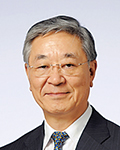Messages from Keidanren Executives and Contributed articles to Keidanren Journals November, 2015 The USA -- the Land of Wealth and Diversity

I first visited the USA in the summer of 1968, when I was still a student of school of engineering at the University of Tokyo. Travelling in the summer holidays, and with limited funds, I went from Los Angels to New York, visiting various Universities and Industries along the way. I was immediately struck by the immense size and wealth of the country, and was impressed by the way Americans keep pushing its frontiers.
Ten years later, in 1978, I visited the country again when I studied at Stanford University, California for a year as a graduate student of Computer Science. There I gained some very practical experience in computer engineering. What impressed me at this particular time was the way that many of the professors had business experience and how the course curriculum was very career oriented. I also noted that the level of cooperation between Universities and the business world was much closer than that it was in Japan. The culture of Silicon Valley was like an "eco system of technological innovation", made possible by strong collaboration between academia and the business world.
Since those days I have travelled to the USA on business many times. The longest period was the four and a half years I spent San Jose at the center of Silicon Valley, starting in 2005. There I was engaged in turning around a faltering Hard Disc Drive manufacturing and sales business.
In the USA, and especially in Silicon Valley, I was impressed at how companies are a kaleidoscope of diversity, made up of all kinds of people, nationalities, languages and cultures, and how this is one of the secrets of their dynamism and a driving force of innovation, even though it may be comparatively difficult to administer at times. In the case of our HDD company, the management was made up of around 20 people from eight different countries, and during meetings you could hear all sorts of different accents. Thus, when working between the two countries, it is important to keep in mind these factors—the huge size of America; the diversity of its people, and the close relationship between industry and academia.
Another thing to keep in mind is that the relationship between USA encompasses much, much more than simple bilateral matters.
The USA is originally made up from immigrants from all over the world, and is thus inherently diverse. Furthermore, being made up of people from all over the world, it naturally has a far reaching influence on various countries, and this is something you always have to take into account in any business dealings or negotiations you may happen to have with Americans.
Another point to keep in mind is that people in America are much more mobile in their careers, as can be seen by how easily people move between academia and the business world. Thus, in communicating with America, I believe that it is important to approach people not only through the business world but also through the academic and political worlds. In July this year, Keidanren actually took a similar approach by sending teams of delegates to visit America on three different courses, the first time for a Japanese business delegation to do so.
The USA is the huge friendly nation that feels close, even if it is on the other side of the Pacific. May the relationship remain strong and continue to flourish far, far into the future.

